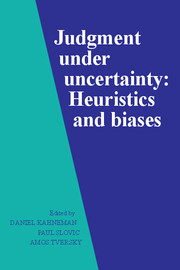Book contents
- Frontmatter
- Contents
- List of contributors
- Preface
- Part I Introduction
- Part II Representativeness
- 2 Belief in the law of small numbers
- 3 Subjective probability: A judgment of representativeness
- 4 On the psychology of prediction
- 5 Studies of representativeness
- 6 Judgments of and by representativeness
- Part III Causality and attribution
- Part IV Availability
- Part V Covariation and control
- Part VI Overconfidence
- Part VII Multistage evaluation
- Part VIII Corrective procedures
- Part IX Risk perception
- Part X Postscript
- References
- Index
4 - On the psychology of prediction
Published online by Cambridge University Press: 05 May 2013
- Frontmatter
- Contents
- List of contributors
- Preface
- Part I Introduction
- Part II Representativeness
- 2 Belief in the law of small numbers
- 3 Subjective probability: A judgment of representativeness
- 4 On the psychology of prediction
- 5 Studies of representativeness
- 6 Judgments of and by representativeness
- Part III Causality and attribution
- Part IV Availability
- Part V Covariation and control
- Part VI Overconfidence
- Part VII Multistage evaluation
- Part VIII Corrective procedures
- Part IX Risk perception
- Part X Postscript
- References
- Index
Summary
In this paper, we explore the rules that determine intuitive predictions and judgments of confidence and contrast these rules to the normative principles of statistical prediction. Two classes of prediction are discussed: category prediction and numerical prediction. In a categorical case, the prediction is given in nominal form, for example, the winner in an election, the diagnosis of a patient, or a person's future occupation. In a numerical case, the prediction is given in numerical form, for example, the future value of a particular stock or of a student's grade point average.
In making predictions and judgments under uncertainty, people do not appear to follow the calculus of chance or the statistical theory of prediction. Instead, they rely on a limited number of heuristics which sometimes yield reasonable judgments and sometimes lead to severe and systematic errors (Kahneman & Tversky, 1972b, 3; Tversky & Kahneman, 1971, 2; 1973, 11). The present paper is concerned with the role of one of these heuristics – representativeness – in intuitive predictions.
Given specific evidence (e.g., a personality sketch), the outcomes under consideration (e.g., occupations or levels of achievement) can be ordered by the degree to which they are representative of that evidence. The thesis of this paper is that people predict by representativeness, that is, they select or order outcomes by the degree to which the outcomes represent the essential features of the evidence.
- Type
- Chapter
- Information
- Judgment under UncertaintyHeuristics and Biases, pp. 48 - 68Publisher: Cambridge University PressPrint publication year: 1982
- 36
- Cited by



